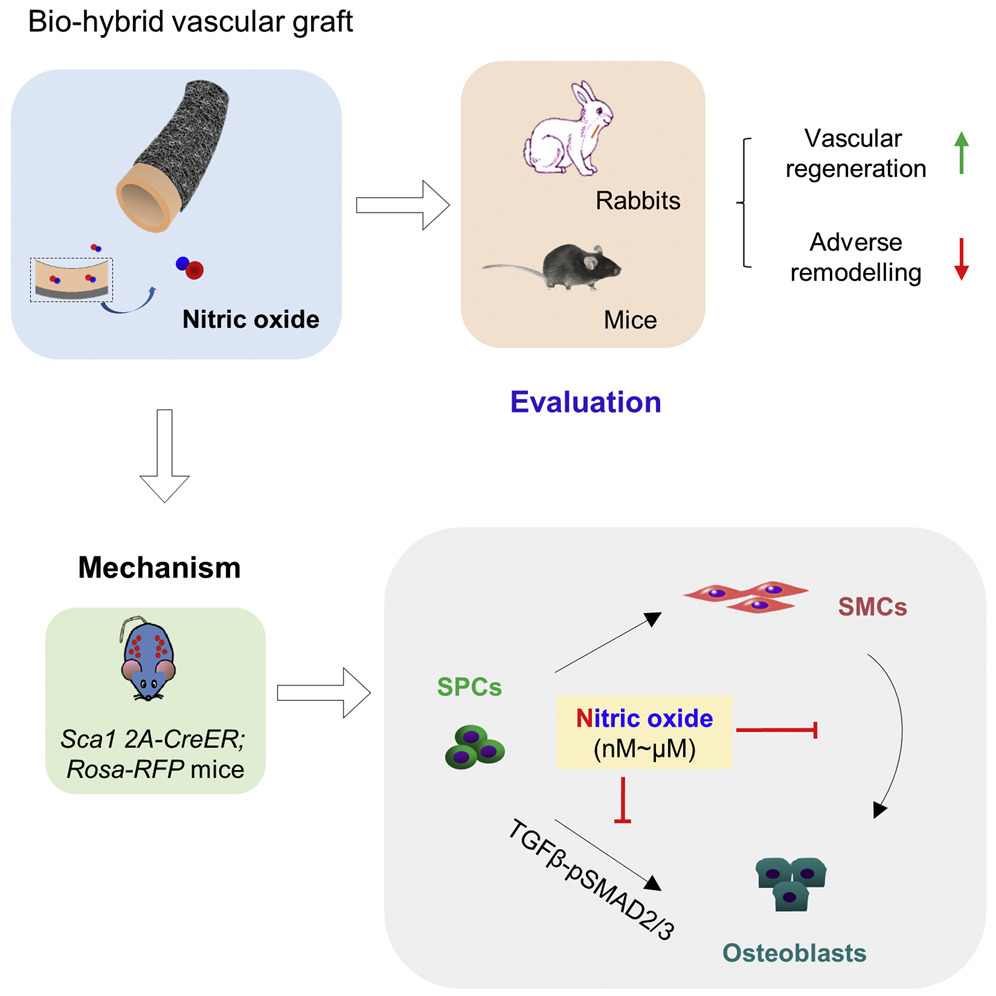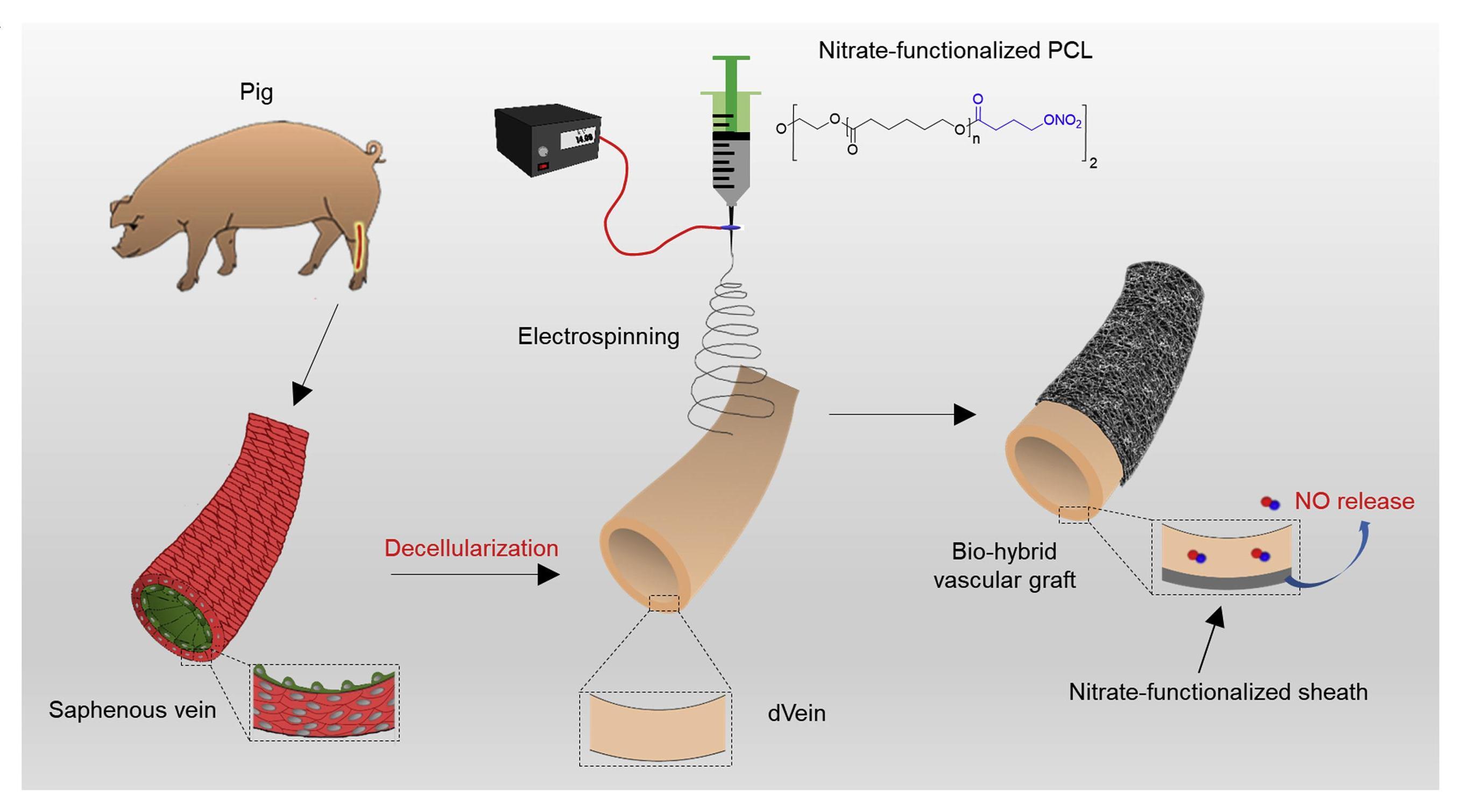Copyright © 2022 Foshan MBRT Nanofiberlabs Technology Co., Ltd All rights reserved.Site Map
1. Research significance of new biological composite vessels
The research team of Professor Zhao Qiang from the School of Life Sciences of Nankai University and the State Key Laboratory of Pharmaceutical Chemistry and Biology and the research team of Professor Xu Qingbo from the First Affiliated Hospital of Zhejiang University School of Medicine jointly developed a new type of biological composite blood vessel with bionic natural blood vessel function. This artificial vessel can slowly release nitric oxide, promote vascular tissue regeneration and inhibit vascular calcification, improve the long-term patency rate of blood vessels, break through the problem of restenosis of small caliber artificial vessels, and has broad clinical application prospects in the field of tissue engineering.

Fig. 1 Biological hybrid blood vessel transplantation
Although the artificial blood vessels made of synthetic materials have been successfully applied in the replacement of large vessels (aorta), the artificial blood vessels with diameter less than 6mm still have no products available for clinical application due to their high incidence of restenosis. Therefore, small caliber artificial blood vessel has always been one of the most challenging research directions in the field of cardiovascular implanting and interventional devices, and also one of the key problems restricting the development of innovative medical devices in China.
2. Innovative design of biological composite artificial blood vessel
In recent years, natural blood vessels derived from animals (pigs) have attracted extensive attention because of their extensive sources, low cost and similar size to human blood vessels. Due to the adverse innate or adaptive immune response caused by the immune potential, xenografts need to be de celled first, including the application of chemical, physical and biological (enzyme) methods alone or in combination. After fully removing the cell debris, the components of extracellular matrix (ECM) and its three-dimensional ultrastructure will be well preserved, which provides the required microenvironment for regulating host response after implantation. Based on the inspiration of various biological functions of NO, the research team designed and manufactured biological hybrid vascular grafts by combining acellular pig veins and functional prostheses with NO release characteristics, combined natural extracellular matrix with electrospun artificial blood vessels, and designed a biological composite artificial blood vessel that can slow the release of nitric oxide.
Innovation: The biological hybrid vascular graft has the function of nitric oxide release, plays an important role in the regulation of vascular calcification, and contributes significantly to the regeneration and remodeling of vascular stem/progenitor cells.

Fig 2 Schematic Diagram of Manufacturing of Biological Blood Vessel Graft
3. Characteristics of new artificial blood vessels
This new artificial blood vessel has a double-layer structure, and the inner layer is the acellular porcine saphenous vein, which can provide good biocompatibility and regeneration; The outer layer is made of nitrate functional material developed by the research group, which plays a mechanical supporting role. After electrospinning, the mechanical strength of composite blood vessels is close to that of natural arteries. More importantly, nitrate ester materials can be converted into nitric oxide through multi-step reaction in vivo and environment. In the research experiment, it was found that in rabbit and mouse models, the continuous release of NO significantly promoted vascular regeneration, including endothelialization, and inhibited adverse remodeling, including intimal hyperplasia and vascular calcification.
In a word, by combining the advantages of acellular vein and functional polymer prosthesis, the biological mixed vascular graft was successfully prepared. After acellular, the saphenous vein is the best 3D microenvironment conducive to vascular regeneration, and the nitrate functionalized PCL polymer is directly electrospun onto the acellular vein, so as to provide sufficient mechanical support to withstand arterial blood flow, effectively inhibit the formation of aneurysm and enhance the patency of carotid artery.
In vascular grafts, the mechanism of neointima formation is somewhat different from that observed in vascular filament injury models. Since the implanted grafts do not contain vascular cells, they will first be refilled by the host cells. After all, the regeneration of vascular grafts is a complex process. It does not rule out that mature endothelial cells and smooth muscle cells migrate in the neointima through the anastomosis to promote endothelial regeneration and smooth muscle accumulation. However, in the appropriate concentration range, NO significantly enhanced the migration and proliferation of endothelial cells in vitro, while it inhibited the migration and proliferation of smooth muscle cells.
Professor Zhao Qiang said: The new artificial blood vessels we have developed have broad market prospects. We will strive to promote its clinical application and improve people's health.
quote: https://doi.org/10.1016/j.celrep.2022.110981
Some of the contents in the text are quoted from Ta Kung Pao
